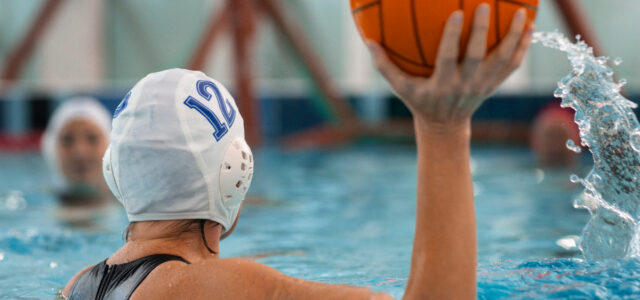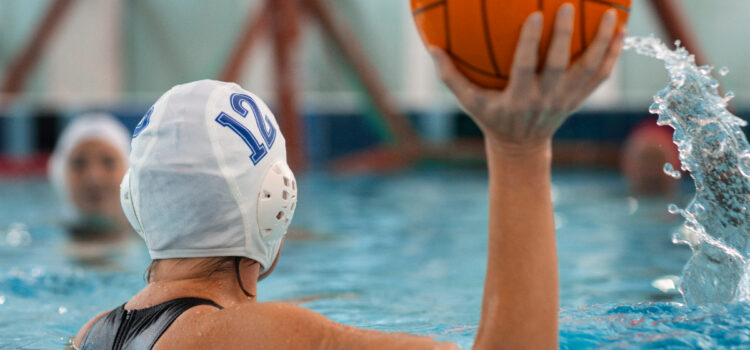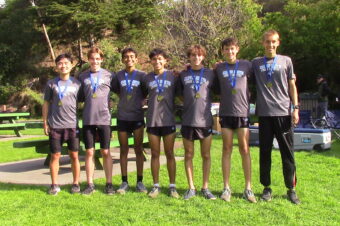

Can Water Polo Players Touch the Pool Floor? Rules Explained & Tips For New Players
AquaticsBlogProduct Reviews/Top Ten Lists/Resources/TipsWater Polo October 11, 2024 Lauren Keating 0

Water polo is a dynamic, fast-paced, and physically demanding sport that combines elements of swimming, soccer, and basketball—all while being played in a pool. The matches consist of two teams of seven players (six field players and a goalkeeper) who try to score goals by throwing a ball into the opposing team’s net. The game is played over four quarters, and the team with the most goals at the end wins.
One of the most common questions newcomers to the sport ask is, “Can water polo players touch the bottom of the pool?”
The short answer is no, but this opens the door to a bigger discussion of the rules and techniques that make water polo a unique and challenging game.
This guide provides gameplay tips and rules for water polo to set new players up for success.
Can Water Polo Players Stand Up in the Pool?
The first key rule is that water polo is that players cannot touch the bottom of the pool. Water polo players also cannot stand up during play.
The sport is typically played in pools at least six to seven feet deep, so standing up would be impossible in most competitive games.
Even in shallower recreational pools, the official rules of water polo (as governed by FINA, the international governing body for aquatic sports) prohibit players from using the pool floor to gain an advantage.
The rule exists because allowing players to touch the bottom would significantly diminish the skill, endurance, and athleticism required to play water polo at a high level.
Why Can’t Players Touch the Bottom of the Pool?
1. Levels the Playing Field
Touching the bottom of the pool would give an unfair advantage for taller players. Water polo is designed to be an equal test of skill, strength, and endurance for players of all sizes. By keeping everyone in the water, the sport ensures that success depends on athletic ability, rather than physical height.
2. Enhances Athleticism
Water polo is known for being one of the most physically demanding sports. Removing the option to rest or touch the bottom means players must develop strong swimming skills and cardiovascular endurance.
3. Strategic Depth
Water polo is a sport that requires players to rise above the water to shoot, block, and pass. By treading water with the eggbeater kick, players can elevate their bodies and create better angles for offensive plays. If players could touch the bottom, it would drastically change the dynamics of shooting, blocking, and passing, leading to a less strategic game.
Are Water Polo Players Swimming the Whole Time?
Water polo players are always in motion. However, they aren’t exactly swimming the entire time.
Players must constantly tread water using a technique called the eggbeater kick. This technique allows players to stay afloat while maintaining balance, stability, and flexibility to react to the game around them. The eggbeater kick is more efficient and sustainable than regular treading, allowing players to conserve energy while also giving them the ability to rise out of the water to catch, throw, or block the ball. This technique is used for a majority of the game.
Players must have physical endurance since the sport requires strong swimming skills, as players are in continuous motion, moving up and down the pool during offensive and defensive plays.
When it comes to actual swimming, players frequently move up and down the pool during counterattacks or defensive transitions.
Water polo is played in a large pool, typically 25 to 30 meters in length, and each of the seven players on the teams must cover significant distances to contribute to both offensive and defensive plays. For this reason, players need to have endurance and swim with speed to be a successful water polo player.
Players are constantly transitioning between different swimming techniques. During a counterattack, players swim at full speed using a front crawl (or freestyle stroke).
When they are moving back into position or playing defense, they might swim backward or sideways to maintain eye contact with the ball and their opponents.
Tips for New Water Polo Players
Given the challenges of never being able to touch the bottom of the pool, here are some tips for new water polo players to improve their game:
Master the Eggbeater Kick
The eggbeater kick is essential for staying afloat and maintaining stamina. Start by practicing this kick in place, focusing on moving your legs in a circular, alternating motion, much like the blades of an eggbeater.
Improve Swimming Endurance
Incorporate a variety of swimming drills into your training, focusing on a mix of speed and endurance. This will help you transition smoothly between offense and defense.
Strengthen Core Muscles
Staying balanced in the water requires strong core muscles. It’s important to incorporate exercises like planks, leg raises, and medicine ball twists into your workout routine.
Develop Ball Handling Skills
Much of the game happens above the surface, so practice handling the ball with one hand while keeping your body upright using the eggbeater kick. Focus on catching, passing, and shooting the ball with precision while staying balanced in the water.
Work on Game Strategy
“Water polo requires both strategic thinking and physical prowess. Players must constantly be mindful of the ball’s position, their teammates, and their opponents. To enhance game awareness, observe seasoned players and analyze game tactics.
Water polo is known for its intensity, requiring endurance, speed, teamwork, and strategic thinking. These tips—while making sure not to stand or touch the bottom of the pool—will set new players up for success.









No comments so far.
Be first to leave comment below.